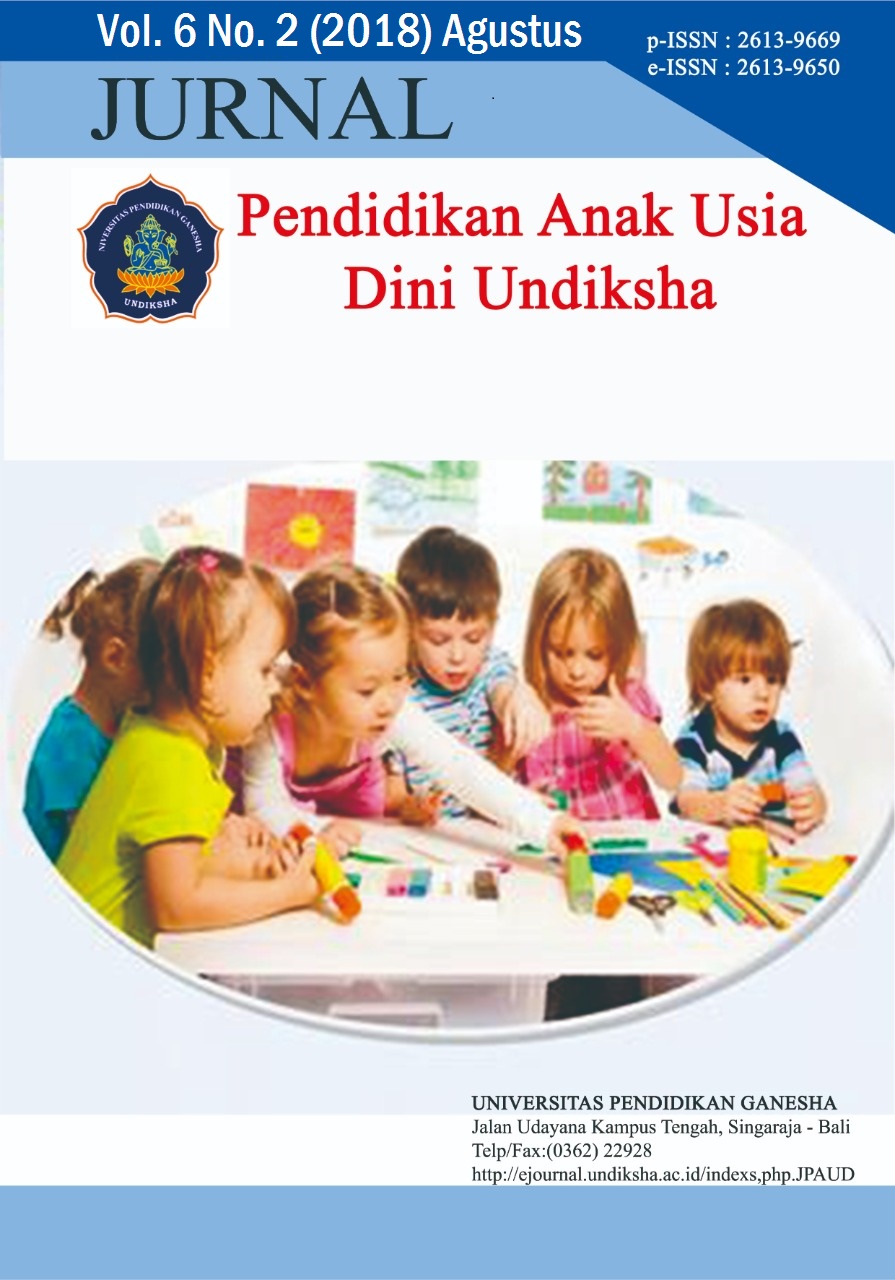PENGARUH ACTIVE LISTENING MELALUI STORY TELLING TERHADAP KEMAMPUAN MENYIMAK ANAK KELOMPOK A
DOI:
https://doi.org/10.23887/paud.v6i2.15281Abstract
Penelitian ini bertujuan untuk mengetahui pengaruh signifikan yang menggunakan active listening melalui story telling dengan anak yang menggunakan model pembelajaran langsung direct instruction terhadap kemampuan menyimak anak kelompok A di Taman Kanak-kanak Gugus II Kecamatan Buleleng Tahun Ajaran 2017/2018. Jenis peneltian ini adalah penelitian eksperimen semu, populasi penelitian ini adalah seluruh kelompok A di gugus II Kecamatan Buleleng Tahun 2017/2018 yang berjumlah 248 anak. Sampel penelitian ini yaitu TK Shaiwa Dharma yang berjumlah 20 anak dan TK Kemala Bhayangkari yang berjumlah 20 anak. Data kemampuan menyimak dikumpulkan dengan menggunakan metode non tes yaitu dengan observasi. Data yang diperoleh dianalisis dengan menggunakan teknik analisis statistik deskriptif dan statistik inferensial yaitu uji-t. Hasil penelitian menunjukkan bahwa terdapat perbedaan kemampua menyimak antara siswa yang menggunakan model pembelajaran actice listening dengan siswa yang tidak menggunakan model pembelajaran active listening dengan thit = 32,409 > ttab 2,042 ini berarti terdapat perbedaan yang signifikan. Berdasarkan hasil analsis data model pembelajaran active listening melalui story telling berpengaruh terhadap kemampuan menyimak. Hal ini dapat dilihat dari skor rata-rata siswa yang menggunakan model pembelajaran active listening yaitu 27,85 dan skor rata-rata siswa yang menggunakan model pembelajaran direct instruction yaitu 16,15. Perbaikan dilakukan dalam proses pembelajaran dengan menggunakan model pembelajaran active listening untuk meningkatkan kemampuan menyimak anak dalam mengatasi kendala-kendala dalam proses pembelajaran di kelas.Kata Kunci : bercerita, active listening, kemampuan menyimak
This study aims to determine the significant influence using story telling method with children using direct instruction model to the ability of listening to group A children in Kugas II Buleleng District School of the School Year 2017/2018. This type of research is a quasi-experimental study, the population of this study is the entire group A in cluster II Buleleng District Year 2017/2018 which amounted to 248 children. The sample of this research is TK Shaiwa Dharma which amounted to 20 children and Kemala Bhayangkari Kindergarten which amounted to 20 children. The listening ability data was collected by using non test method with observation. The data obtained were analyzed using descriptive and inferential statistical analysis technique, t-test. The result of research shows that there is difference of listening ability between students using actice listening learning model with students who do not use active listening learning model with thit = 32,409 > ttab 2,042 this means there is significant difference. Based on the results of analysis data model of active listening learning through story telling influence on the ability to listen. This can be seen from the average score of students using active listening learning model that is 27.85 and the average score of students using direct instruction model that is 16.15. Improvement is done in the learning process by using active listening learning model to improve the ability to listen to children in overcoming obstacles in the process of learning in class.
keyword : story telling, listening ability, active listening
Published
2018-07-27
How to Cite
., N. P. D. T., ., P. D. N. K. S. M. K., & ., M. M. S. M. (2018). PENGARUH ACTIVE LISTENING MELALUI STORY TELLING TERHADAP KEMAMPUAN MENYIMAK ANAK KELOMPOK A . Jurnal Pendidikan Anak Usia Dini Undiksha, 6(2), 126–135. https://doi.org/10.23887/paud.v6i2.15281
Issue
Section
Articles
License
Authors who publish with the Jurnal Pendidikan Anak Usia Dini Undiksha agree to the following terms:
- Authors retain copyright and grant the journal the right of first publication with the work simultaneously licensed under a Creative Commons Attribution License (CC BY-SA 4.0) that allows others to share the work with an acknowledgment of the work's authorship and initial publication in this journal.
- Authors are able to enter into separate, additional contractual arrangements for the non-exclusive distribution of the journal's published version of the work (e.g., post it to an institutional repository or publish it in a book), with an acknowledgment of its initial publication in this journal.
- Authors are permitted and encouraged to post their work online (e.g., in institutional repositories or on their website) prior to and during the submission process, as it can lead to productive exchanges, as well as earlier and greater citation of published work. (See The Effect of Open Access)











